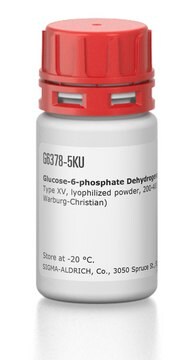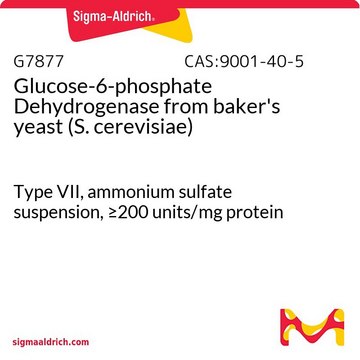H4502
Hexokinase from Saccharomyces cerevisiae
Type F-300, lyophilized powder, ≥130 units/mg protein (biuret)
Synonym(s):
Hexokinase D, Hexokinasetype IV, ATP:D-Hexose-6-phosphotransferase, Hexokinase from yeast
About This Item
Recommended Products
biological source
Saccharomyces cerevisiae
Quality Level
type
Type F-300
form
lyophilized powder
specific activity
≥130 units/mg protein (biuret)
mol wt
110 kDa
purified by
crystallization
storage condition
(Keep container tightly closed in a dry and well-ventilated place)
color
white
anion traces
sulfate (SO42-): free
foreign activity
ATPase, myokinase, glucose-6-phosphate dehydrogenase, 6-phosphogluconic dehydrogenase and phosphoglucose isomerase ≤0.01%
storage temp.
−20°C
Gene Information
bakers yeast ... HXK1(850614) , HXK2(852639)
Looking for similar products? Visit Product Comparison Guide
General description
The hexokinase 1 (HXK1) gene is mapped to the Saccharomyces cerevisiae chromosome VI. HXK1 is ubiquitously expressed in mammalian tissues and is abundant in the brain, erythrocytes, lymphocytes, and fibroblasts.
Application
- for digesting glucose for measuring glucose content in the root and stem samples of Quercus velutina
- to treat ADP (adenosine diphosphate) solution along with D-glucose to remove the contaminating ATP (adenosine triphosphate)
- in 4-(2-hydroxyethyl)-1-piperazineethanesulfonic acid buffer (pH 7.5) for ADP-[13CU]glucose synthesis
Biochem/physiol Actions
The rate of phosphorylation varies with different hexoses (pH 7.5, 30 °C).
D-fructose KM: 0.33 mM
D-glucose KM: 0.12 mM
D-mannose KM: 0.05 mM
Yeast hexokinase exists as two similar isoforms, PI and PII (A and B), with isoelectric points of 5.25 and 4, respectively.
Molecular Weight: ~ 54 kDa (monomer)
~110 kDa (dimer)
Optimal pH: 7.5 to 9.0
Extinction Coefficient: E1% = 8.85 (PI) and 9.47 (PII) at 280 nm
Activators: Hexokinase requires Mg2+ ions (KM = 2.6 mM) for activity. Hexokinase is activated by catecholamines and related compounds.
Inhibitors: sorbose-1-phosphate, polyphosphates, 6-deoxy-6-fluoroglucose, 2-C-hydroxy-methylglucose, xylose, lyxose, and thiol reactive compounds (Hg2+ and 4-chloromercuribenzoate)
Quality
Unit Definition
Physical form
Reconstitution
related product
Storage Class Code
11 - Combustible Solids
WGK
WGK 3
Flash Point(F)
Not applicable
Flash Point(C)
Not applicable
Personal Protective Equipment
Certificates of Analysis (COA)
Search for Certificates of Analysis (COA) by entering the products Lot/Batch Number. Lot and Batch Numbers can be found on a product’s label following the words ‘Lot’ or ‘Batch’.
Already Own This Product?
Find documentation for the products that you have recently purchased in the Document Library.
Customers Also Viewed
Protocols
Enzymatic Assay of Hexokinase
Our team of scientists has experience in all areas of research including Life Science, Material Science, Chemical Synthesis, Chromatography, Analytical and many others.
Contact Technical Service








